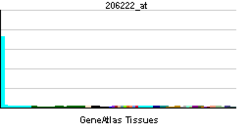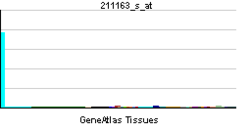| TNFRSF10C | |||||||||||||
|---|---|---|---|---|---|---|---|---|---|---|---|---|---|
| Идентификаторы | |||||||||||||
| Символ | TNFRSF10C ; CD263; DCR1; DCR1-TNFR; LIT; TRAIL-R3; TRAILR3; TRID | ||||||||||||
| Внешние ID | OMIM: 603613 HomoloGene: 48244 GeneCards: TNFRSF10C Gene | ||||||||||||
| |||||||||||||
| Профиль экспрессии РНК | |||||||||||||
 | |||||||||||||
 | |||||||||||||
 | |||||||||||||
| Больше информации | |||||||||||||
| Ортологи | |||||||||||||
| Вид | Человек | Мышь | |||||||||||
| Entrez | 8794 | n/a | |||||||||||
| Ensembl | ENSG00000173535 | n/a | |||||||||||
| UniProt | O14798 | n/a | |||||||||||
| RefSeq (мРНК) | NM_003841 | n/a | |||||||||||
| RefSeq (белок) | NP_003832 | n/a | |||||||||||
| Локус (UCSC) | Chr 8: 22.94 – 22.97 Mb | n/a | |||||||||||
| Поиск в PubMed | n/a | ||||||||||||
TNFRSF10C (англ. tumor necrosis factor receptor superfamily, member 10C) — мембранный белок, рецептор из надсемейства рецепторов факторов некроза опухоли. Продукт гена человека TNFRSF10C.[1][2][3]
Функции
TNFRSF10C входит в многочисленное надсемейство рецепторов факторов некроза опухоли (TNFR). Является рецептором для лиганда цитотоксичности TRAIL. Не содержит домен смерти, поэтому не способен инициировать апоптоз, может защищать клетки от TRAIL-индуцированного апоптоза.[4]
Структура
Белок состоит из 259 аминокислоты, молекулярная масса — 27,4 кДа. После созревания и отщепления сигнального пептида остаётся 211 аминокислот. N-концевой внеклеточный домен содержит 3 повтора TNFR-Cys и 5 TAPE повторов. Кроме этого, домен содержит до 3 участков N-гликозилирования.
Тканевая специфичность
Высокая экспрессия обнаружена в лейкоцитах периферической крови, селезёнке, скелетных мышцах, плаценте, лёгких и сердце.
См. также
Примечания
- ↑ Degli-Esposti MA, Smolak PJ, Walczak H, Waugh J, Huang CP, DuBose RF, Goodwin RG, Smith CA (Nov 1997). “Cloning and characterization of TRAIL-R3, a novel member of the emerging TRAIL receptor family”. J Exp Med. 186 (7): 1165—70. DOI:10.1084/jem.186.7.1165. PMC 2199077. PMID 9314565.
- ↑ MacFarlane M, Ahmad M, Srinivasula SM, Fernandes-Alnemri T, Cohen GM, Alnemri ES (Nov 1997). “Identification and molecular cloning of two novel receptors for the cytotoxic ligand TRAIL”. J Biol Chem. 272 (41): 25417—20. DOI:10.1074/jbc.272.41.25417. PMID 9325248.
- ↑ Entrez Gene: TNFRSF10C tumor necrosis factor receptor superfamily, member 10c, decoy without an intracellular domain.
- ↑ www.uniprot.org/uniprot/O14798
Литература
- Kimberley FC, Screaton GR (2005). “Following a TRAIL: update on a ligand and its five receptors”. Cell Res. 14 (5): 359—72. DOI:10.1038/sj.cr.7290236. PMID 15538968.
- Pan G, Ni J, Wei YF; et al. (1997). “An antagonist decoy receptor and a death domain-containing receptor for TRAIL”. Science. 277 (5327): 815—8. DOI:10.1126/science.277.5327.815. PMID 9242610.
- Sheridan JP, Marsters SA, Pitti RM; et al. (1997). “Control of TRAIL-induced apoptosis by a family of signaling and decoy receptors”. Science. 277 (5327): 818—21. DOI:10.1126/science.277.5327.818. PMID 9242611.
- Schneider P, Bodmer JL, Thome M; et al. (1997). “Characterization of two receptors for TRAIL”. FEBS Lett. 416 (3): 329—34. DOI:10.1016/S0014-5793(97)01231-3. PMID 9373179.
- Mongkolsapaya J, Cowper AE, Xu XN; et al. (1998). “Lymphocyte inhibitor of TRAIL (TNF-related apoptosis-inducing ligand): a new receptor protecting lymphocytes from the death ligand TRAIL”. J. Immunol. 160 (1): 3—6. PMID 9551946.
- Rieger J, Naumann U, Glaser T; et al. (1998). “APO2 ligand: a novel lethal weapon against malignant glioma?”. FEBS Lett. 427 (1): 124—8. DOI:10.1016/S0014-5793(98)00409-8. PMID 9613612.
- Sheikh MS, Huang Y, Fernandez-Salas EA; et al. (1999). “The antiapoptotic decoy receptor TRID/TRAIL-R3 is a p53-regulated DNA damage-inducible gene that is overexpressed in primary tumors of the gastrointestinal tract”. Oncogene. 18 (28): 4153—9. DOI:10.1038/sj.onc.1202763. PMID 10435597.
- Leverkus M, Walczak H, McLellan A; et al. (2000). “Maturation of dendritic cells leads to up-regulation of cellular FLICE-inhibitory protein and concomitant down-regulation of death ligand-mediated apoptosis”. Blood. 96 (7): 2628—31. PMID 11001921.
- Zhang XD, Nguyen T, Thomas WD; et al. (2000). “Mechanisms of resistance of normal cells to TRAIL induced apoptosis vary between different cell types”. FEBS Lett. 482 (3): 193—9. DOI:10.1016/S0014-5793(00)02042-1. PMID 11024459.
- Dörr J, Bechmann I, Waiczies S; et al. (2002). “Lack of tumor necrosis factor-related apoptosis-inducing ligand but presence of its receptors in the human brain”. J. Neurosci. 22 (4): RC209. PMID 11844843.
- Liao Q, Friess H, Kleeff J, Büchler MW (2002). “Differential expression of TRAIL-R3 and TRAIL-R4 in human pancreatic cancer”. Anticancer Res. 21 (5): 3153—9. PMID 11848467.
- Bretz JD, Mezosi E, Giordano TJ; et al. (2002). “Inflammatory cytokine regulation of TRAIL-mediated apoptosis in thyroid epithelial cells”. Cell Death Differ. 9 (3): 274—86. DOI:10.1038/sj/cdd/4400965. PMID 11859410.
- Hueber A, Aduckathil S, Kociok N; et al. (2002). “Apoptosis-mediating receptor-ligand systems in human retinal pigment epithelial cells”. Graefes Arch. Clin. Exp. Ophthalmol. 240 (7): 551—6. DOI:10.1007/s00417-002-0487-6. PMID 12136286.
- Matysiak M, Jurewicz A, Jaskolski D, Selmaj K (2002). “TRAIL induces death of human oligodendrocytes isolated from adult brain”. Brain. 125 (Pt 11): 2469—80. DOI:10.1093/brain/awf254. PMID 12390973.
- Ruiz de Almodóvar C, López-Rivas A, Redondo JM, Rodríguez A (2002). “Transcription initiation sites and promoter structure of the human TRAIL-R3 gene”. FEBS Lett. 531 (2): 304—8. DOI:10.1016/S0014-5793(02)03544-5. PMID 12417331.
- Strausberg RL, Feingold EA, Grouse LH; et al. (2003). “Generation and initial analysis of more than 15,000 full-length human and mouse cDNA sequences”. Proc. Natl. Acad. Sci. U.S.A. 99 (26): 16899—903. DOI:10.1073/pnas.242603899. PMC 139241. PMID 12477932.
- Ou D, Metzger DL, Wang X; et al. (2003). “TNF-related apoptosis-inducing ligand death pathway-mediated human beta-cell destruction”. Diabetologia. 45 (12): 1678—88. DOI:10.1007/s00125-002-0926-2. PMID 12488957.
- Hasel C, Dürr S, Rau B; et al. (2003). “In chronic pancreatitis, widespread emergence of TRAIL receptors in epithelia coincides with neoexpression of TRAIL by pancreatic stellate cells of early fibrotic areas”. Lab. Invest. 83 (6): 825—36. PMID 12808117.
Ссылки
- TNFR (TNF-рецепторы). (рус.)
Данная страница на сайте WikiSort.ru содержит текст со страницы сайта "Википедия".
Если Вы хотите её отредактировать, то можете сделать это на странице редактирования в Википедии.
Если сделанные Вами правки не будут кем-нибудь удалены, то через несколько дней они появятся на сайте WikiSort.ru .